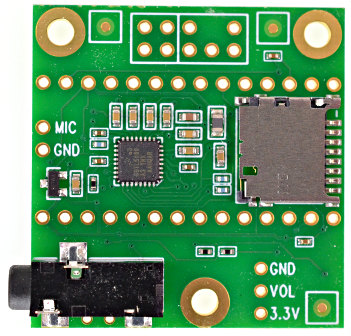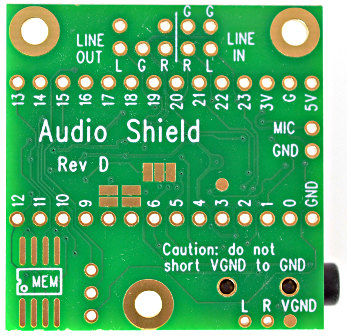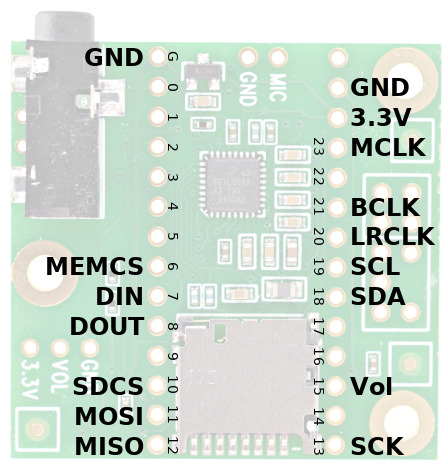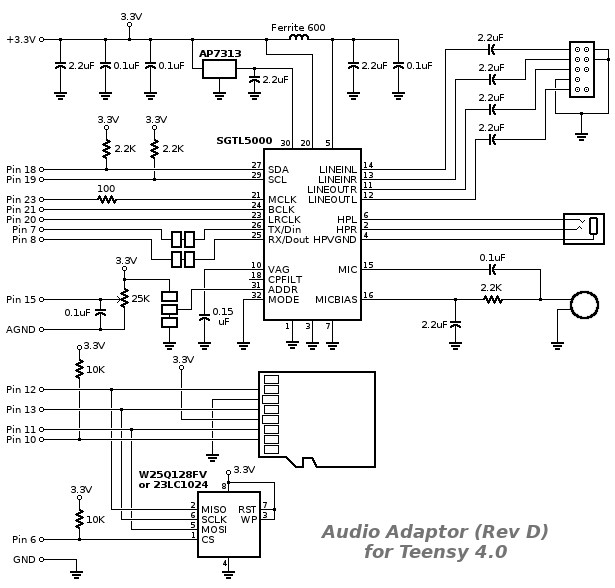
This audio adaptor lets you easily add high quality 16 bit, 44.1 kHz sample rate (CD quality) audio to your projects with Teensy 3.0, 3.1, 3.2, 3.5, 3.6 (Rev C), or 4.0 (Rev D). The older versions can be used with Teensy 4.0 by wires or an adaptor PCB.
All versions of the audio shield support stereo headphone and stereo line-level output, and also stereo line-level input or mono microphone input.
The Teensy Audio Library lets you use the input and output simultaneously together with a toolkit of audio processing objects, to easily create all types of sophisticated audio applications. You can play multiple sound files, create synthesized waveforms, apply effects, mix multiple streams and output high quality audio to the headphones or line out pins.
| Function | Teensy 4.x Pins Rev D |
Shareable |
|---|---|---|
| Audio Data | 7, 8, 20, 21, 23 | |
| Audio Control | 18, 19 | SDA, SCL (other I2C chips) |
| Volume Pot | 15 (A1) | - |
| SD Card | 10, 11, 12, 13 | MOSI, MISO, SCK (other SPI chips) |
| Memory Chip | 6, 11, 12, 13 | MOSI, MISO, SCK (other SPI chips) |
| Front Side Rev D (for Teensy 4.0) |
|---|
 |
| Back Side Rev D (for Teensy 4.0) |
|---|
 |
| Rev D (Teensy 4.0) |
|---|
 |
| Audio Shield Signal |
Rev D (Teensy 4.x) |
Function |
|---|---|---|
| MCLK | 23 (MCLK1) |
Audio Master Clock, 11.29 MHz |
| BCLK | 21 (BCLK1) |
Audio Bit Clock, 1.41 or 2.82 MHz |
| LRCLK | 20 (LRCLK1) |
Audio Left/Right Clock, 44.1 kHz |
| DIN | 7 (OUT1A) |
Audio Data from Teensy to Audio Shield |
| DOUT | 8 (IN1) |
Audio Data from Audio Shield to Teensy |
| SCL | 19 | Control Clock (I2C) |
| SDA | 18 | Control Data (I2C) |
| SCK | 13 | Data Storage (SPI) Clock |
| MISO | 12 | Data Storage (SPI) from SD/MEM to Teensy |
| MOSI | 11 | Data Storage (SPI) from Teensy to SD/MEM |
| SDCS | 10 | Chip Select (SPI) for SD Card |
| MEMCS | 6 | Chip Select (SPI) for Memory Chip |
| Vol | 15 / A1 | Volume Thumbwheel (analog signal) |
The SD socket is accessed with 4 SPI pins. SCLK and MOSI are used at alternate locations. See the audio library examples for details on how to select these different pins. The SD card is useful for playing music. Sandisk and other good quality SD cards are capable of playing 2 WAV files simultaneously.
Wires for MCLK, BCLK, LRCLK, TX & RX should be kept short. The audio shield is meant to connect to Teensy through short pins. Wires can be used, but wires must be short to avoid problems.
The line in/out header uses a pinout compatible with the AC97 audio header on PC motherboards. The front panel cables from most PCs can be connected, or wires can be soldered directly to the pins.
Schematic, Rev D

In September 2019, Rev D was created for Teensy 4.0. The circuitry is the same as Rev C, but the I2S digital audio signals and SPI signals for the SD card are routed to the pins Teensy 4.0 uses.





